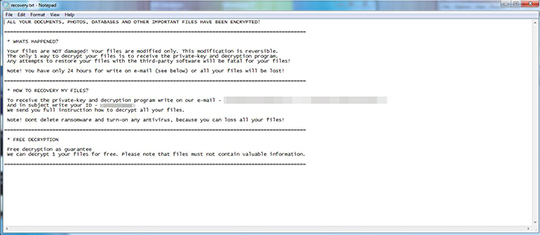RANSOM_RAPID.THBABAH
Trojan-Ransom.Win32.Cryptor.bqr (Kaspersky) , Ransom:Win32/GandCrab.A (Microsoft) , Trojan Horse (Norton)
Windows


Threat Type: Ransomware
Destructiveness: No
Encrypted: No
In the wild: Yes
OVERVIEW
This Ransomware arrives on a system as a file dropped by other malware or as a file downloaded unknowingly by users when visiting malicious sites.
TECHNICAL DETAILS
Arrival Details
This Ransomware arrives on a system as a file dropped by other malware or as a file downloaded unknowingly by users when visiting malicious sites.
Installation
This Ransomware drops the following files:
- %Application Data%\info.exe -> copy of itself
- %Application Data%\recovery.txt -> ransom note
- {encrypted folder}\How Recovery Files.txt -> ransom note
(Note: %Application Data% is the Application Data folder, where it usually is C:\Documents and Settings\{user name}\Application Data on Windows 2000, Windows Server 2003, and Windows XP (32- and 64-bit); C:\Users\{user name}\AppData\Roaming on Windows Vista (32- and 64-bit), Windows 7 (32- and 64-bit), Windows 8 (32- and 64-bit), Windows 8.1 (32- and 64-bit), Windows Server 2008, and Windows Server 2012.)
It adds the following processes:
- vssadmin.exe Delete Shadow /All /Quiet
- cmd.exe /C bcdedit /set {default} recoveryenabled No
- cmd.exe /C bcdedit /set {default} bootstatuspolicy ignoreallfailures
- cmd.exe /c wbadmin DELETE SYSTEMSTATEBACKUP
- cmd.exe /c wmic SHADOWCOPY DELETE
It adds the following mutexes to ensure that only one of its copies runs at any one time:
- BleepingComputer_rapid
Autostart Technique
This Ransomware adds the following registry entries to enable its automatic execution at every system startup:
HKEY_CURRENT_USER\Software\Microsoft\
Windows\CurrentVersion\Run
Encrypter_074 = %Application Data%\info.exe
HKEY_CURRENT_USER\Software\Microsoft\
Windows\CurrentVersion\Run
userinfo = %Application Data%\recovery.txt
Process Termination
This Ransomware terminates the following processes if found running in the affected system's memory:
- agntsvc.exe
- agntsvc.exe
- ashDisp.exe
- avengine.exe
- avgnt.exe
- AVP.EXE
- cfp.exe
- cmdagent.exe
- dbeng50.exe
- dbsnmp.exe
- ekrn.exe
- encsvc.exe
- excel.exe
- firefoxconfig.exe
- fsguiexe.exe
- infopath.exe
- isqlplussvc.exe
- Mcshield.exe
- msaccess.exe
- msftesql.exe
- msmpeng.exe
- mspub.exe
- mydesktopqos.exe
- mydesktopservice.exe
- mysqld.exe
- mysqld-nt.exe
- mysqld-opt.exe
- NortonAntiBot.exe
- ocautoupds.exe
- ocomm.exe
- ocssd.exe
- onenote.exe
- oracle.exe
- outlook.exe
- pccpfw.exe
- persfw.exe
- powerpnt.exe
- smc.exe
- sqbcoreservice.exe
- sqlagent.exe
- sqlbrowser.exe
- sqlservr.exe
- sqlwriter.exe
- steam.exe
- synctime.exe
- taskmgr.exe
- tbirdconfig.exe
- thebat.exe
- thebat64.exe
- thunderbird.exe
- visio.exe
- winword.exe
- wordpad.exe
- xfssvccon.exe
Other Details
This Ransomware adds the following scheduled tasks:
- Task Name: Encrypter
Schedule: Every minute
Task to be run: %Application Data%\info.exe - Task Name: EncrypterSt
Schedule: On Logon
Task to be run: %Application Data%\info.exe
(Note: %Application Data% is the Application Data folder, where it usually is C:\Documents and Settings\{user name}\Application Data on Windows 2000, Windows Server 2003, and Windows XP (32- and 64-bit); C:\Users\{user name}\AppData\Roaming on Windows Vista (32- and 64-bit), Windows 7 (32- and 64-bit), Windows 8 (32- and 64-bit), Windows 8.1 (32- and 64-bit), Windows Server 2008, and Windows Server 2012.)
Ransomware Routine
This Ransomware avoids encrypting files found in the following folders:
- Windows
- intel
- nvidia
- temp
It appends the following extension to the file name of the encrypted files:
- .rapid
NOTES:
This ransomware displays the following image after execution:
SOLUTION
Step 1
Before doing any scans, Windows XP, Windows Vista, and Windows 7 users must disable System Restore to allow full scanning of their computers.
Step 2
Note that not all files, folders, and registry keys and entries are installed on your computer during this malware's/spyware's/grayware's execution. This may be due to incomplete installation or other operating system conditions. If you do not find the same files/folders/registry information, please proceed to the next step.
Step 3
Delete this registry value
Important: Editing the Windows Registry incorrectly can lead to irreversible system malfunction. Please do this step only if you know how or you can ask assistance from your system administrator. Else, check this Microsoft article first before modifying your computer's registry.
- In HKEY_CURRENT_USER\Software\Microsoft\Windows\CurrentVersion\Run
- Encrypter_074 = %Application Data%\info.exe
- Encrypter_074 = %Application Data%\info.exe
- In HKEY_CURRENT_USER\Software\Microsoft\Windows\CurrentVersion\Run
- userinfo = %Application Data%\recovery.txt
- userinfo = %Application Data%\recovery.txt
Step 4
Search and delete this file
- %Application Data%\info.exe -> copy of itself
- %Application Data%\recovery.txt -> ransom note
- {encrypted folder}\How Recovery Files.txt -> ransom note
Step 5
Deleting Scheduled Tasks
The following {Task Name} - {Task to be run} listed should be used in the steps identified below:
- Encrypter - %Application Data%\info.exe
- EncrypterSt - %Application Data%\info.exe
For Windows 2000, Windows XP, and Windows Server 2003:
- Open the Windows Scheduled Tasks. Click Start>Programs>Accessories>
System Tools>Scheduled Tasks. - Locate each {Task Name} values listed above in the Name column.
- Right-click on the said file(s) with the aforementioned value.
- Click on Properties. In the Run field, check for the listed {Task to be run}.
- If the strings match the list above, delete the task.
For Windows Vista, Windows 7, Windows Server 2008, Windows 8, Windows 8.1, and Windows Server 2012:
- Open the Windows Task Scheduler. To do this:
• On Windows Vista, Windows 7, and Windows Server 2008, click Start, type taskschd.msc in the Search input field, then press Enter.
• On Windows 8, Windows 8.1, and Windows Server 2012, right-click on the lower left corner of the screen, click Run, type taskschd.msc, then press Enter. - In the left panel, click Task Scheduler Library.
- In the upper-middle panel, locate each {Task Name} values listed above in the Name column.
- In the lower-middle panel, click the Actions tab. In the Details column, check for the {Task to be run} string.
- If the said string is found, delete the task.
Step 6
Scan your computer with your Trend Micro product to delete files detected as RANSOM_RAPID.THBABAH. If the detected files have already been cleaned, deleted, or quarantined by your Trend Micro product, no further step is required. You may opt to simply delete the quarantined files. Please check the following Trend Micro Support pages for more information:
Step 7
Restore encrypted files from backup.
Did this description help? Tell us how we did.

